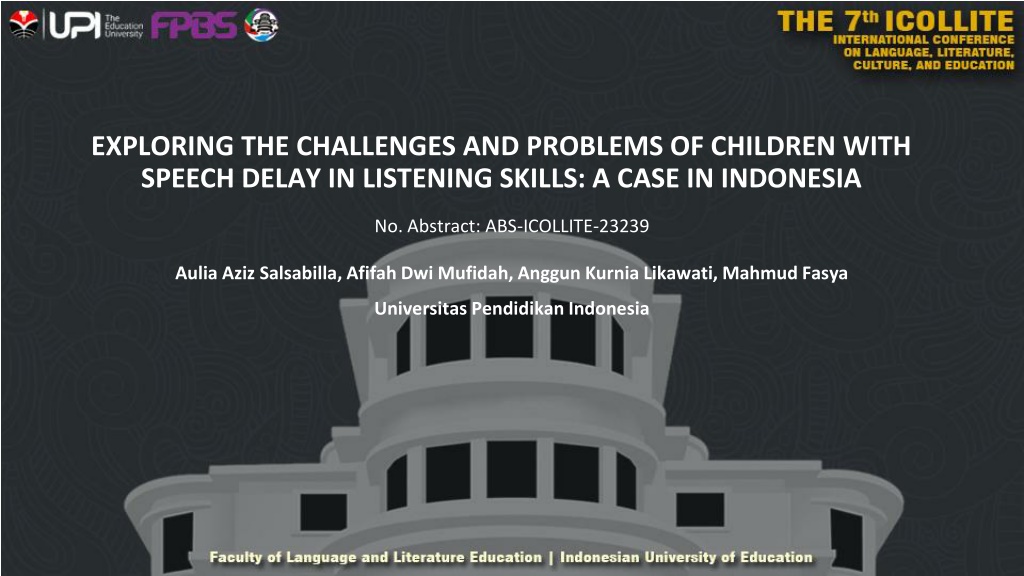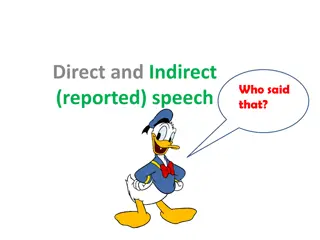Understanding Challenges Faced by Children with Speech Delay in Listening Skills: A Case Study in Indonesia
Speech delay can hinder a child's ability to develop language skills, impacting areas such as listening, attention, and socialization. In Indonesia, 20% of children face speech delay, posing challenges in listening and language production. This study delves into the difficulties encountered by children with speech delay, focusing on their listening abilities and language development.
Download Presentation

Please find below an Image/Link to download the presentation.
The content on the website is provided AS IS for your information and personal use only. It may not be sold, licensed, or shared on other websites without obtaining consent from the author. Download presentation by click this link. If you encounter any issues during the download, it is possible that the publisher has removed the file from their server.
E N D
Presentation Transcript
EXPLORING THE CHALLENGES AND PROBLEMS OF CHILDREN WITH SPEECH DELAY IN LISTENING SKILLS: A CASE IN INDONESIA No. Abstract: ABS-ICOLLITE-23239 Aulia Aziz Salsabilla, Afifah Dwi Mufidah, Anggun Kurnia Likawati, Mahmud Fasya Universitas Pendidikan Indonesia
INTRODUCTION Speech delay is a condition in which a child is unable to develop speech and language skills as expected. This problem is associated with increased difficulties in reading, writing, listening, attention, and socialization. Symptoms of speech and language delay include lack of the ability to pronounce and understand simple words, talking in short sentences, or simply telling short stories. Twenty percent (20%) of children in Indonesia have a speech delay, which means if there are 5 million children, 1 million children have a speech delay. In the process of language acquisition, children with speech delay are very difficult in listening, which inhibits their language production. What are the challenges and problems that children with speech delay face in the domains of listening and language production?
LITERATURE REVIEW According to the Indonesian Pediatric Association (IDAI), speech and language difficulties are a common developmental-problem in five to eight percent (5%-8%) of preschool-aged children. This problem is associated with increased difficulties in reading, writing, listening, attention, and socialization. According to Yagang (1994), the problems in listening were accompanied with the four following factors: the message, the speaker, the listener and the physical setting.
METHOD Subject of the Research Approach Research Method Model Theory Qualitative Case study with an observation method 2 children Milles and Huberman ( AD and AT , aged 10 years)
FINDING AND DISCUSSION Indicators that need to be analyzed to evaluate the listening ability of children with speech delay include: 1. Ability to Understand Instructions 2. Response to Questions 3. Understanding Stories and Experiences 4. Recognizing and Understanding Words 5. Listening in a Group or Class
FINDING AND DISCUSSION AT s Speech and Language Ability Based on assessment and observation data, AT has been able to explain information about cause-and-effect, although with incomplete and non sequitur sentences. At this time, AT still often shows reversed words when speaking, as well as the use of incomplete oral sentences. AT is also often confused or does not know some words, due to the lack of meaningful experience of the use of the word. However, if the question asked to AT is delivered in a long or complex sentence, AT still has difficulty answering it. AT must be introduced with concrete vocabulary and understanding the meaning of the word which consists of nouns, verbs, and adjectives. AT also needs practice to express his desires, and tell information to others in sequence. AT also still needs practice listening, and performing multilevel instructions with the use of more complex language/sentences.
FINDING AND DISCUSSION AD s Speech and Language Ability In understanding sentences, AD still has difficulty understanding the content of the reading so AD usually practices using sentence structure first. AD also still has to be helped by reading the sentences directly using intonation, for example an interrogative sentence with a questioning intonation, so AD can determine the punctuation marks that must be used. In the antonym material, AD can understand the meaning and can even determine the antonyms of the words, but for synonyms AD still has to be helped by demonstrating the movements or characteristics of the word. AD still has difficulty telling the story in a concise manner. In complete sentences, AD only mentions the key words. When the teacher is explaining, AD has difficulty focusing and chooses to play alone and is difficult to be directed.
CONCLUSION Listening skills are an important part of language learning. Children with special needs, especially those with speech delay, have some difficulties in understanding commands and sentence structures. Based on the description of the case study and previous observations, we found a method that we think can be used as one of the common threads that can bridge students to develop their linguistic insights, namely the bibliotherapy method. Bibliotherapy can be developed for problems related to mental, intellectual language, and social interaction for children with special needs which are included in the clinical bibliotherapy aspect.
REFERENCES Badawieh, M., & Al-Shamsi, A. (2023). The factors that impact the Speech delay in the first three years of a child s life. Journal of Language and Linguistic Studies, 19(1), 13-20. Evandio, A. (2022, May 20). Darurat Speech Delay, 20 persen Anak RI Alami Terlambat Bicara. Bisnis Style. https://lifestyle.bisnis.com/read/20220520/106/1535165/darurat-speech-delay-20-persen-anak- ri-alami-terlambat-bicara Leung, A. K., & Kao, C. P. (1999). Evaluation and management of the child with speech delay. American family physician, 59(11), 3121 3135. McLaughlin, M. R. (2011). Speech and language delay in children. American family physician, 83(10), 1183 1188. Morgan, S. J., Pullon, S. R. H., Macdonald, L. M., McKinlay, E. M., & Gray, B. V. (2017). Case Study Observational Research: A Framework for Conducting Case Study Research Where Observation Data Are the Focus. Qualitative Health Research, 27(7), 1060 1068. Syamsuardi. (2015). Speech Delay and Its Affecting Factors (Case Study in a Child with Initial Aq). Journal of Education and Practice, 6(32), 68-71. Yagang, F. (1994). Listening: Problems and solutions. In T. Kral (ed.), Teacher Development: Making the Right Moves. English Language Programs Divisions, USIA
THANK YOU! Follow us on Instagram @bestari.withgwyn























